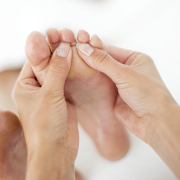 iStockphoto/Thinkstock
iStockphoto/Thinkstock
I remember my first time. It was in the morning and I woke up in excruciation pain.
The sciatica pain was absolutely horrible, shooting down my lower back towards my leg, wrapped around my hip. The pain was mind-numbing, and a move to the right or left of my bed only made it intensify.
I’d heard stories from friends and my husband about the temporarily paralyzing pain of sciatica which left them immobilized on their bathroom or office floors. I always thought they were being overly dramatic or regurgitating urban legends.
To make matters worse, I was heartsick because we were supposed to depart that morning to visit friends in Boston. After a heated discussion with my husband, I called my BFF in Boston and told her my health dilemma.
She completely understood as she was a marathon runner and had periodic episodes of sciatica pain. She also delivered some excellent health advice.
She mentioned that she would pop some Tylenol and put ice on the area. She also said DO NOT lay around for more than 24 hours, and to go for a walk. Take your time, she advised, and walk very slowly to exercise and stretch the muscle.
This advice was so counter-intuitive.
Go for a walk. Is she kidding?
But I was willing to give anything a try as the pain was tremendous. By mid-afternoon, I became stir-crazy and decided to take our family dog for a walk.
I figured if I fell and was lying in the ditch screaming in pain, my dog could run home or to my neighbor’s house for help.
The most painful part of this exercise was getting out of my bed, putting on my pants and walking down the stairs.
But, after 45 minutes of ugly pain faces and 15 steps out my front door, my hip and lower back started to feel some relief.
Granted, I felt like I was walking like I had a load in my pants but the pain had finally lessened. Activity had actually made my sciatica pain lessen.
Now, to keep my sciatica demons away, I take daily walks and if I feel a slight tinge of a possible flare, I apply ice.
Also, I do sit-ups daily and try to get to the pool three or four times per week. It seems that intense or constant pressure on the nerve invites a flare-up of pain.
However, this health advice worked for my muscle issue and may not work if you have another medical issue.
If you believe you have a herniated disc, you should contact your doctor immediately.
Contact your health care practitioner if you have any of the following:
• Loss of control of urine or stool (incontinence)
• Pain that is worse when you lie down, or awakens you at night
• Unexplained fever with back pain
• Burning with urination or blood in your urine
• Back pain after a severe blow or fall
• Weakness or numbness in your buttocks, thigh, leg, or pelvis
• Redness or swelling on the back or spine
• Pain traveling down your legs below the knee
• Severe pain and you cannot get comfortable
Next week: the best sleeping positions for sciatica pain.
References:
Advice to rest in bed versus advice to stay active for acute lowâ€back pain and sciatica - PubMed Health. National Center for Biotechnology Information. Retrieved June 29, 2012, from
http://www.ncbi.nlm.nih.gov/pubmedhealth/PMH0014541
Sciatica - PubMed Health. National Center for Biotechnology Information. Retrieved June 29, 2012, from
http://www.ncbi.nlm.nih.gov/pubmedhealth/PMH0001706
Reviewed June 29, 2012
by Michele Blacksberg RN
Edited by Jody Smith





Add a Comment1 Comments
This is a well written article, and unique because it also promotes an optimistic and active response to sciatica pain.
I own and operate www.BackPainCo.com, and sciatica is one of our customers' most common complaints. Unfortunately, this is because sciatica can 'flare' for small, diverse reasons.
A good response for mild to moderate sciatica pain is gentle exercise, lumbar support and inflammatory medications. Gentle exercise, such as walking or yoga, will loosen your lumbar muscles and increase blood flow. A Lumbar Back Brace will support your lower back to ensure healthy range of motion is maintained and will alleviate pressure from your sciatic nerve. Inflammatory medications will reduce swelling in your lumbar muscles which may be putting extra pressure on your sciatic nerve.
Link to Articles: http://backpainco.com/pages/back-pain-information/back-pain-articles.html
Link to Sciatica Back Brace: http://backpainco.com/best-sellers/sacroiliac-back-brace/
Hope this helps,
Beau Schmitt
July 6, 2012 - 1:48pmThis Comment